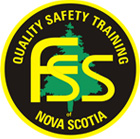Loading Truck on Slope – Potential Hazards
Hazard Alert
Loading Trucks on a Slope
Parking and loading a centre-mount log truck while on a steep slope can be a dangerous situation for the following reasons:
- The driver is very vulnerable while sitting atop the loader, especially if the loader is leaning.
- Brakes and stabilizers may not hold the truck in position if one or the other fails.
- The driver does not have control of the truck in the loading position. If the truck slides or rolls, the driver may be thrown from the seat.
- If the boom is extended and hydraulic pressure is lost, the boom will swing, following the slope, and possibly throwing the driver from the seat.
- It is more difficult to climb up and down the loader (ladder) if it is on an angle. There will be an increased risk of slipping or falling.
Recommendations to Prevent a Recurrence
This hazard can be minimized in several ways by both the harvesting and trucking contractors.
Harvesting Contractors can help reduce the hazard in the following ways:
- Where possible, avoid piling wood in a place that forces the truck driver to park and load on a steep slope.
- Communicate with truck drivers to effectively manage inventory to avoid running out of room for certain products.
Trucking Contractors can help reduce the hazard in the following ways:
- If drivers see forwarder operators piling wood in an unsafe location, let them know so they can pile in a safer location.
- Communicate with operators to effectively manage inventory to avoid running out of room for certain products.
- Trucks should be kept in safe working order.
- If a driver must load on a slope, they should chock the wheels prior to climbing onto the loader.
- Drivers should avoid loading on steep slopes when slippery conditions are present.
- Drivers should wear their seat belt while sitting on the loader.
- Tire chains should be used during icy conditions.
The best way to avoid this situation is to avoid piling wood in dangerous locations. This can be done through good communication and inventory management between harvesting crews and trucking fleets.
